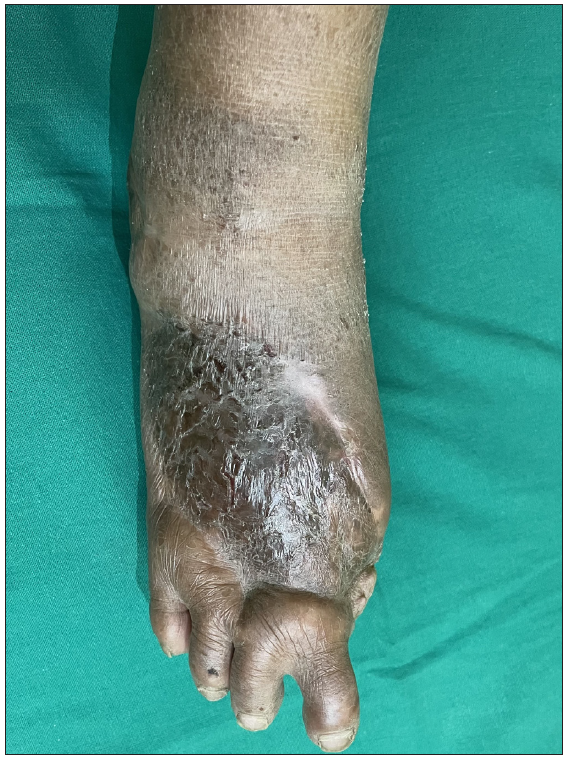Translate this page into:
Autonomic denervation dermatitis
Corresponding author: Dr. Anupam Das, Department of Dermatology, KPC Medical College and Hospital, Kolkata, West Bengal, India. anupamdasdr@gmail.com
-
Received: ,
Accepted: ,
How to cite this article: Das A, Pal S, Ray D. Autonomic denervation dermatitis. Indian J Dermatol Venereol Leprol. 2025;91:130. doi: 10.25259/IJDVL_73_2024
A 49-year-old woman presented with a well-demarcated plaque on the dorsal aspect of the right foot [Figure 1]. She was a known case of inadequately controlled type 2 diabetes mellitus and ischaemic heart disease. There was a history of local debridement and amputation of the great toe of the right foot owing to a diabetic foot ulcer five years ago, following which skin grafting was done. Two years after the surgery, she developed itching and discharge from the dorsum of the right foot, on the skin graft site and the symptoms gradually increased to attain the present status.

- Scaly plaque on the dorsum of the right foot, over the skin graft site.
Cutaneous examination revealed a well-demarcated oozy plaque surmounted by scales, on the dorsum of the right foot. There was loss of crude and fine touch from mid-calf downwards on the right leg including the lesion. Superficial and deep pain and temperature sensations were absent locally. A clinical diagnosis of autonomic denervation dermatitis over the graft site was made. The patient was prescribed halobetasol 0.05% and fusidic acid 2% cream along with emollients. Autonomic denervation dermatitis refers to the development of eczematous lesions around the site of surgical incisions, months to years after the surgery. The underlying pathomechanism is autonomic disturbance following dermal nerve transections. Our case can also be regarded as an example of Ruocco’s immunocompromised cutaneous district. Therapeutic options include liberal application of emollients and judicious use of topical corticosteroids.
Declaration of patient consent
The authors certify that they have obtained all appropriate patient consent.
Financial support and sponsorship
Nil.
Conflicts of interest
There are no conflicts of interest.
Use of artificial intelligence (AI)-assisted technology for manuscript preparation
The authors confirm that there was no use of artificial intelligence (AI)-assisted technology for assisting in the writing or editing of the manuscript and no images were manipulated using AI.





